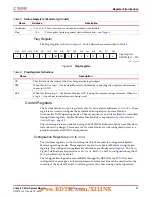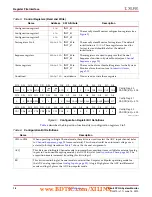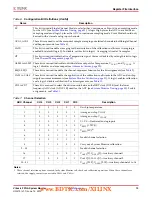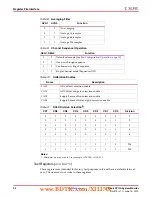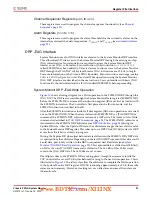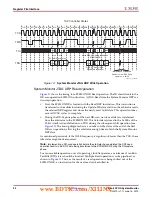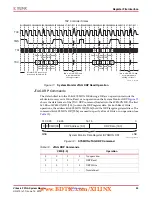
Virtex-6 FPGA System Monitor
25
UG370 (v1.1) June 14, 2010
System Monitor Control Logic
JTAGLOCKED signal is activated by writing
0001h
to DRP address
00h
. The
JTAGLOCKED signal is reset again by writing
0000h
to DRP address
00h
.
System Monitor Control Logic
Many of the most commonly used system monitoring functions are implemented in the
System Monitor control logic. Common functions include:
•
Channel sequencer
•
Measurement averaging
•
Maximum and minimum internal sensor measurements
•
Automatic alarms on internal sensors
•
Sensor and ADC calibration
The control logic also decodes the configuration registers to configure the ADC sampling
modes (see
System Monitor Timing, page 33
) and external analog-input configuration (see
Channel Sequencer
When bits SEQ1 and SEQ0 in Control Register
41h
are set to logic 1 (see
System Monitor operates in Single Channel mode. In this mode, the user must select the
channel for Analog-to-Digital conversion by writing to the bit locations CH0 to CH4 in
control register
40h
. Operating modes for Single Channel mode, such as analog input
mode (BU) and acquisition time (ACQ), must also be set by writing to Control Register
40h
. In applications where many channels need to be monitored, this can mean a
significant overhead for the microprocessor or other controller. To automate this task, a
function called the Channel Sequencer is provided.
The Channel Sequencer provides a method for the user to set up a predefined sequence of
channels (both internal and external) to be automatically monitored. The Channel
Sequencer function is implemented using eight control registers from address
48h
to
4Fh
on the DRP (see
). These eight registers can be viewed as four
pairs of 16-bit registers. Each pair of registers controls one aspect of the sequencer
functionality. Individual bits in each pair of registers (32 bits) enable a specific functionality
for a particular ADC channel. The four pairs of registers are:
•
ADC channel selection (
48h
and
49h
)
•
ADC channel averaging enables (
4Ah
and
4Bh
)
•
ADC channel analog-input mode (
4Ch
and
4Dh
)
•
ADC channel acquisition time (
4Eh
and
4Fh
)
System Monitor only operates in Continuous Sampling mode (see
) when the automatic channel sequencer is enabled. Sequencer mode is enabled by
using bits SEQ1 and SEQ0 in Configuration register 1 (see
). The Channel Sequencer registers should be initialized by the user when
System Monitor is instantiated in a design (see
System Monitor Primitive, page 8
). The
Channel Sequencer can also be reconfigured via the DRP at run time. The Sequencer must
first be disabled by writing to bits SEQ1 and SEQ0 before writing to any of the Channel
Sequencer registers. It is recommended the System Monitor is placed in safe mode by
writing zeros to SEQ0 and SEQ1 while updating the Control Registers. System Monitor is
automatically reset
whenever SEQ1 and SEQ0 are changed. The current status register
www.BDTIC.com/XILINX







